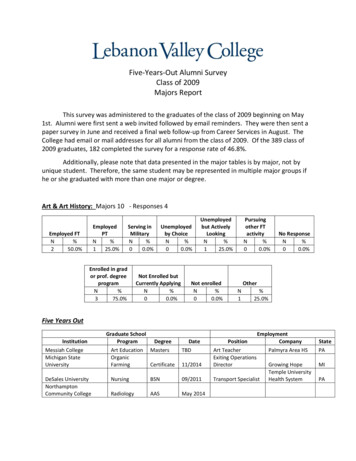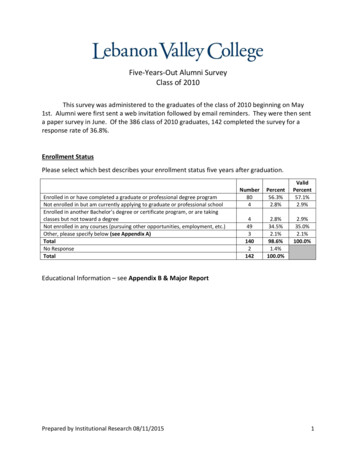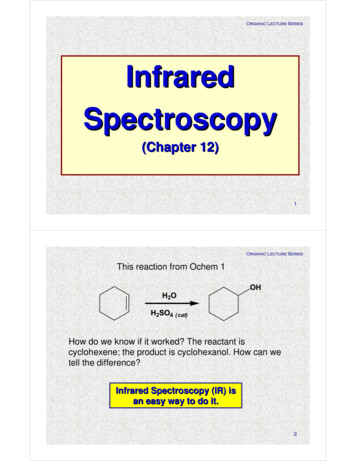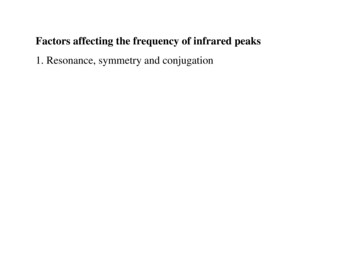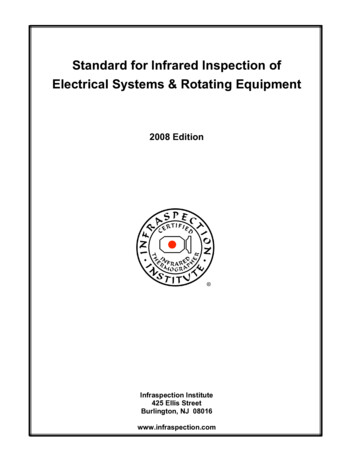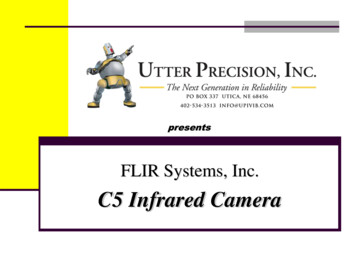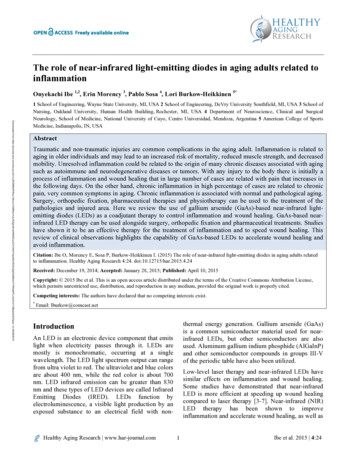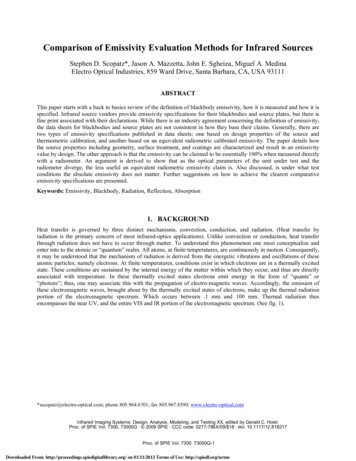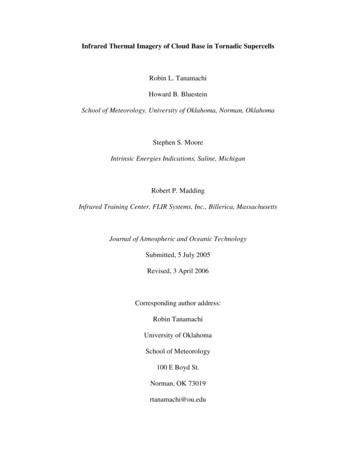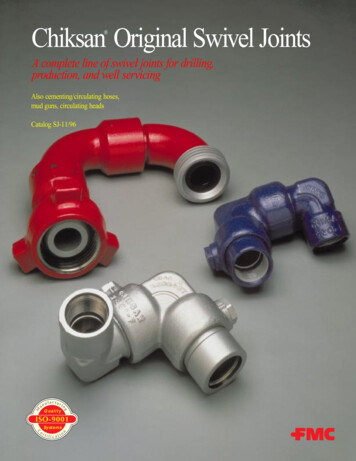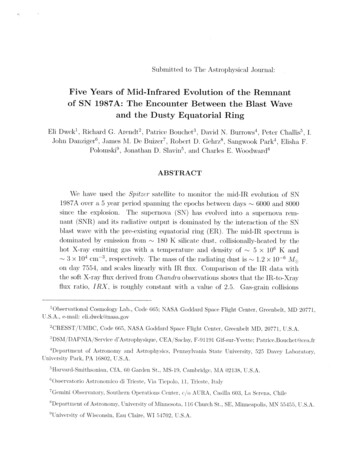
Transcription
Submitted to The Astrophysical Journal:Five Years of Mid-Infrared Evolution of the Remnantof SN 1987A: The Encounter Between the Blast Waveand the Dusty Equatorial RingEli Dwek l , Richard G. Arendt 2 , Patrice Bouchet', David N. Burrows'. Peter Challis', I.John Danziger 6 , James M. De BIIizer 7 , Robert D. Gehrz s , Sangwook Park, Elisha F.Poloinski', Jonathan D. Slavin 5 , and Charles E. NNVoodward8ABSTRACTWe have used the SpitZff satellite to monitor the laid-IR evolution of SN1987A over a 5 year period spanning the epochs between days — 6000 and 8000since the explosion. The supernova (SN) has evolved into a supernova remnant (SNR) and its radiative output, is dominated by the interaction of the SNblast wave with the pre-existing ecluatorial ring (ER). The mid-IR. spectrum isdominated by emission from 180 K silicate dust., collisionally-heated by thehot: X-ray emitting gas with a temperature and density of — 5 x 10 6 K andN 3 x 10 t e111 -3 , respectively. The mass of the radiating dust is — 1.2 x 10 - 6 .111on day 7554, and scales linearly with IR, flux. Comparison of the III, data: withthe soft X-ray flux derived from. Chandra observations shows that the 111-to-Xrayflux ratio, tRX. is roughly constant with a value of 2.5. Gas-grain collisions'Observational Cosmology Lab., Code. 665; NASA Goddard Space Flight Center ; Greenbelt, Ml) 201771,U.S.A., e-mail: eli.dwek64nasa.gov 'CRESST'UNIBC, Code 665, NASA Goddard Space Flight Center. Greenbelt MD. 20771 U.S.A. 'DSNI'DAPtiIA/Service d'Astrophysique, CEA, r'Saclay, F-91191 Gif-sur-Yvette: Patrice. Bouchet ,,Qce .fr'Dcpartirmit of Astronomy and Astrophysics, Pennsylvania State University, 525 Davey Laboratory.University Park, PA 16802, U.S.A.5 1-larvard-Smithsonian, CfA, 60 Garden St., 11S-19, Cambridge, NIA 02138, U.S.A.f3 0sservatorio Astroiloniico di Trieste, Via Tiepolo, 11, Trieste, Italy' Geiiliili Observatory. Southern Operations Center, c/o At R.A. Casilla 603, La Serelia, Chiles Department of Astronomy, University of 1liinnsota, 116 Church St., SE, Minneapolis, XIN 55455, U.S.A. 17nivei.sity of Wisconsin, Ean Claire, Wl 54702, U.S.A.
2therefore dominate the cooling of the shocked gas. The constancy of IRX ismost consistent with the scenario that very little grain processing or gas coolinghave occurred throughout this epoch. The shape of the dust spectrum remainedunchanged during the observations while the total flux increased by a factor of5 with a time dependence of t" -O.20 , t' being the tine since the first encounter between the blast wave and the ER. These observations are consistentwith the transitioning of the blast wave from free expansion to a Sedov phase asit propagates into the main body of the ER,, as also suggested by X-ray observations. The constant spectral shape of they IR, emission provides strong constraintson the density and temperature of the shocked gas in which the interaction takesplace. The LR, spectra also suggest the presence of a secondary population ofvery small, hot (T ? 350 K), featureless dust. If these grains spatially coexistswith the silicates, then they must have shorter lifetimes. The data show slightlydifferent rates of increase of their respective fluxes, lending some support to thishypothesis. However, the origin of this emission component and the exact natureof its relation to the silicate emission is still a, major unsolved puzzle.Subject he adircgs: ISNI: supernova remnants -- ISM: individual (SNR. 1987A) ISM: interstellar dust - Infrared: general - X-rays: general1. INTRODUCTIONAbout 10 years after its explosion on February 23, 1987, supernova (SN) 1987A hasevolved from a supernova, when its radiative output was dominated by the release of radioactive decay energy in the ejecta, into a supernova remnant (SNR), when its radiativeoutput became dominated by the interaction of its blast wave with the inner equatorial ring(ER). The ER is located it a distance of about 0.7 lyr from the center of the explosion, andcould have been produced by mass loss from a single rotating supergiant (Heger k- La.rrger1998) or by a merger event in a binary system which also formed the two outer rings (Morris& Podsiadlowski 2009). The transition from SN to SNR was observed at wavelengths rangingfrom radio to X-rays, and is summarized in Figure 18 in Bouchet et al. (2006).In this paper we report oil the continuing evolution of the 5 — 30 pin spectrum andthe 3.6, 4.5, 5.8, 8.0, ind 24 darn photometric fluxes from SN 1987A. spanning the y — 5 yearperiod from day — 6000 until day — 8000 after the explosion. Initial reports and analysis ofthe IR. evolution were presented by Bouchet et al. (2004. 2006) and D-,Nek et al. (2008). In;2 we present the IR data obtained by the Spltzcr'satellite. The evolution of the IR, emissionMid the dust composition are presented in §3. Ili §4 we derive the plasma conditions from
3-the IR, observations. The comparison of the III, emission with the X-ray emission, and theinevolution of their flux ratio are discussed'5. A brief summary of the paper is presentedin§6.2. OBSERVATIONS AND DATA REDUCTIONSI)AWY 78 observations using IRAC. IRS, and MIPS were conducted annually (hiringthe first two years (2004--2005), and then roughly every 6 montlis for the remainder of itscryogenic mission. SN 1987A was also observed incidentally with IRAC and MIPS by theSAGE survey (Meixiier et al. 2006) and other projects during 2005Figures 1 and 2 illustrate the IRAC data at the final observations (— day 8000). TheIRAC data are all of good quality, i.e. the data are not adversely affected by any artifactsinininduced b ythe field orprior observations. Initial tests of generatingn sourcesmosaics from the basic calibrated data (BCD) showed no significant difference from the postBCD mosaics. Therefore, aperture photometry was performed on the post-BCD mosaics inandorder to obtain the broad band evolution of S1987A at 3.6. 4.5, 5.88 pin. These,ineasurements and their statistical uncertainties are show ii in Figure 3.Figures Iand2 also illustrate the MIPS 24 and 70 pin images of SN 1987A at Day 7983.There is no evident point source at 70 pin. As for IRAC, there seemed to be no advantage toreprocessing the BCD, thus aperture photometry was performed on the post-BCD mosaics.The 24 pin flux densities are: in Figure 3. At Day 7983, a 70 pin upper limit wasandetermined by addingartificial point, source to the MIPS image at the location of the SN.Nk e started with a source flux that was clearly visible above the background confusion, andthen reduced the flux until the source was no longer detected using the FIND routine of theIDLASTRO library. The results indicate the S(701m) 0.09 Jy.A significant complication with the IRAC and MIPS photometry is that the SN isnot resolved from the nearby Star 2 and Star 3. If the stars are assumed to have. mid-111,aremagnitudes that(,.(trial to the K magnitudes (15,06, 15.80 respectively from N,Talborii etthenal 1993),their combined III, flux densities should be 0.41. 0.26, 0.16, 0.09, and 0.01n0v at 3.6, 4.5 5.8. & and 24 pin, respectivel y. These assumptions inay be accurate for Star2, which is identified as a B2 III star (kk7alborn et al. 1993, Scuderi et al. 1996)., howeverA-alborn, et al. (1993) report both. an III excess and a variability by at least Am I inaginfor Star 3. The fltLx(,sFigure 3 are plotted after subtraction of the emission of Stars 2 and3 under these assumptions.HISobservations were reduced starting with the BCD, and using the basic steps out-
--- 4 -lined in the IRS Data Handbook. For the low resolution (R — 60 — 120) data, we constructed a 2-D background frame using the observations of a specific off source target position. IRS CLEAN -MASK was used to identify and clean rouge: pixels in the backgrcnllicl .subtracted BCD frames. The cleaned BCD data, were averaged for each nod (positions of thesource at 1/3 or 2/3 the length of the slit), and spectra were extracted froinn these super BCDsusing SPICE. After extraction, the spectra orders were merged to produce the full spectrashown in Figure 3 (top right panel). The high resolution (R — 600) data were processedin a similar fashion. The major difference was that instead of using a background from adedicated ofd source target, the background is derived from tll( average of two pointings thatflank the SN on opposite sides (15" and 25" away for the SH and LH spectra respectively).The position angle of these pointings varied as dictated by the scheduling of the observations.but the distance of the paintings from the SN remained constant. For both the high and lowresolution data, SMART was used to fit and extract line fluxes.3. THE EVOLUTION OF THE INFRARED EMISSION AND THE DUSTCOMPOSITION IN THE ERFigure 3 depicts the evolution of the IRAC and TNIIPS broad band photometry (top leftpanel), and the low-resolution IRS spectrum of SNR 1987A (top right panel), as a functionof time. The relatively strong background may affect the continuum at A 20 pm and the[Ne III] 15.6 ,tam and [S I11] 18.7, 33.5 pill emission lines. Line emission from SN 1987Aand its surrounding medium will be presented elsewhere (Arendt et al; in preparation).The figures show that the IR flux is rising smoothly in all bands, increasing by a factor of— 3 betNveen days 6190 and 7980. The bottoirr left panel of the figure shows the spectranormalized by least-square fit, to the one obtained on day 7554. The spectrum maintaineda nearly constant shape throughout the 1500 days of observations. This constancy enablesthe use of any IRAC or 24 jinn NIPS band as a prox y of the total integrated IR flux fromthe ER. The bottom right panel in the figure shows the ratio between the integrated IR fluxand the 24 pm flux from the ER. The ratio is constant with a value of 1.64 to within The constancy in the spectral shape also places strong constraints on the parameters of thehot X-ray gas in which the grains are embedded.Figure 4 (left panel) shows that the inean spectrum of the ER can be well fitted byastronomical silicate grains radiating at a. single temperature of — 180 K. The relative ratiobet-,N-een the two peaks of the silicate features provide strong constraints oil the tempci-ature.The mass of the silicate dust is 1.2 x 10 - ' 11 oil day 7554, and should scale linearly withthe IR flux for other epochs (see Table 1). The figure also shows the presence of all IR.
-5--excess at wavelengths between — 5 — 8putwhich cannot be attributed to emission from thesilicate grains. This excess emission was first detected by Bouchet et al. (2006), but was notfurther pursued because of the shorter integration tune and larger noise of that earlySpitzcrspectrum. An unidentified K-band (2.2 put) continuum at a level of — 0.4 mJv, detected bybeKjwr et al. (200 70, maypart of this emission component. This emission component, nowclearla y present in all epochs. , (,artavpowerlawbeapproximated in the 5 to 8 yin wavelength region bywith a spectral index of a ti —1.8. This rules out thermal brenisstralihing,which has a well defined spectral index of a . —0.1 in this frequency regime, as a possiblesource. Synchrotron radiation can also be ruled as a source of this emission component. Theobserved radio synchrotron emission (Zanardo et al. 2010) has a spectral index of —0.8,and its extrapolation from a value of 300 iuJv at 1.4 GHz on day 7000 will make a negligiblecontribution to the 8 yin emission around that epoch. Nk"o therefore conclude that thisemission arises from an additional hot dust component that is tightly correlated with thesilicate emission. Its spectral shape should be featureless at longer wavelengths as to not,.,spoil" the fit to the observed 9.7 and 18putsilicate emission features. The right panel ofthe figure shows the fit of a blackbody spectrum. modified by a A cinissivity law and atemperature of — 350 K, to this component.The modified blackbody is of course an idealized representation of this secondary dustcomponent. Figure5 shows a two-component fit to the IR, spectrum when the secondarycomponent was taken to consist ofeithercarbon,i-on, pureiron, magnetite(FeA)4) , or isulfide(FeS) grains. All components, combined with the main silicate dust component, providedacceptable fits to the overallIR, spectrum of the ER. The temperature of the secondary dustcornpoilent is gencrally significantly higher than that of the silicate grains, ranging from—370 K for pure iron grains to — 460 K for carbon grains. Some other possible secondarydust components, in particular silicates and alluninuin oxides, were ruled out because of thepresenc(-x of strong emission features at wavelengths above —8 pin.The problem of accounting for the widely different temperatures of the two dust components. even though theymay be collisiorially-heated bythe same gas, will be addressed in 4 below.4.PLASMA CONDITIONS AS DERIVED FROM IR OBSERVATIONSFigurc,6 shows the plasma densities required to collisionally beat the different graintyp es to their respective ternperat tires g iven in Figure 5 as a function of grain radius. Thegrains are assumed to be embedded in an ionized plasnia with a temperature of 5 x 10' K,reflecting the average temperature of the soft X-r( --1Y component (see, §5 below). If we require
-6--both dust components to arise from the same gas, then only the carbon grains support arange of plasma densities (enclosed between the two horizontal dashed lilies) that overlapwith that of the silicate, grains. So the IR, spectrum of the ER, is consistent with the emissionfrom a population of small (a 0.65 µm) carbon grains intermixed with a populationof large (a 0.20 /tm) silicate grains embedded in a plasma with a density n e n H ti(2 — 4) x 104 cm - 3 . Requiring a common environment for the two dust components rules outthe other dust compositions (Fe, Fe3 04 , and FeS) as viable dust candidates. Alternativelythe emission could arise from these grains, provided they reside in a significan
dioactive decay energy in the ejecta, into a supernova remnant (SNR), when its radiative output became dominated by the interaction of its blast wave with the inner equatorial ring (ER). The ER is located it a distance of about 0.7 lyr from the center of the explosion, and could have been produced by mass loss from a single rotating supergiant (Heger k- La.rrger 1998) or by a merger event in a .
